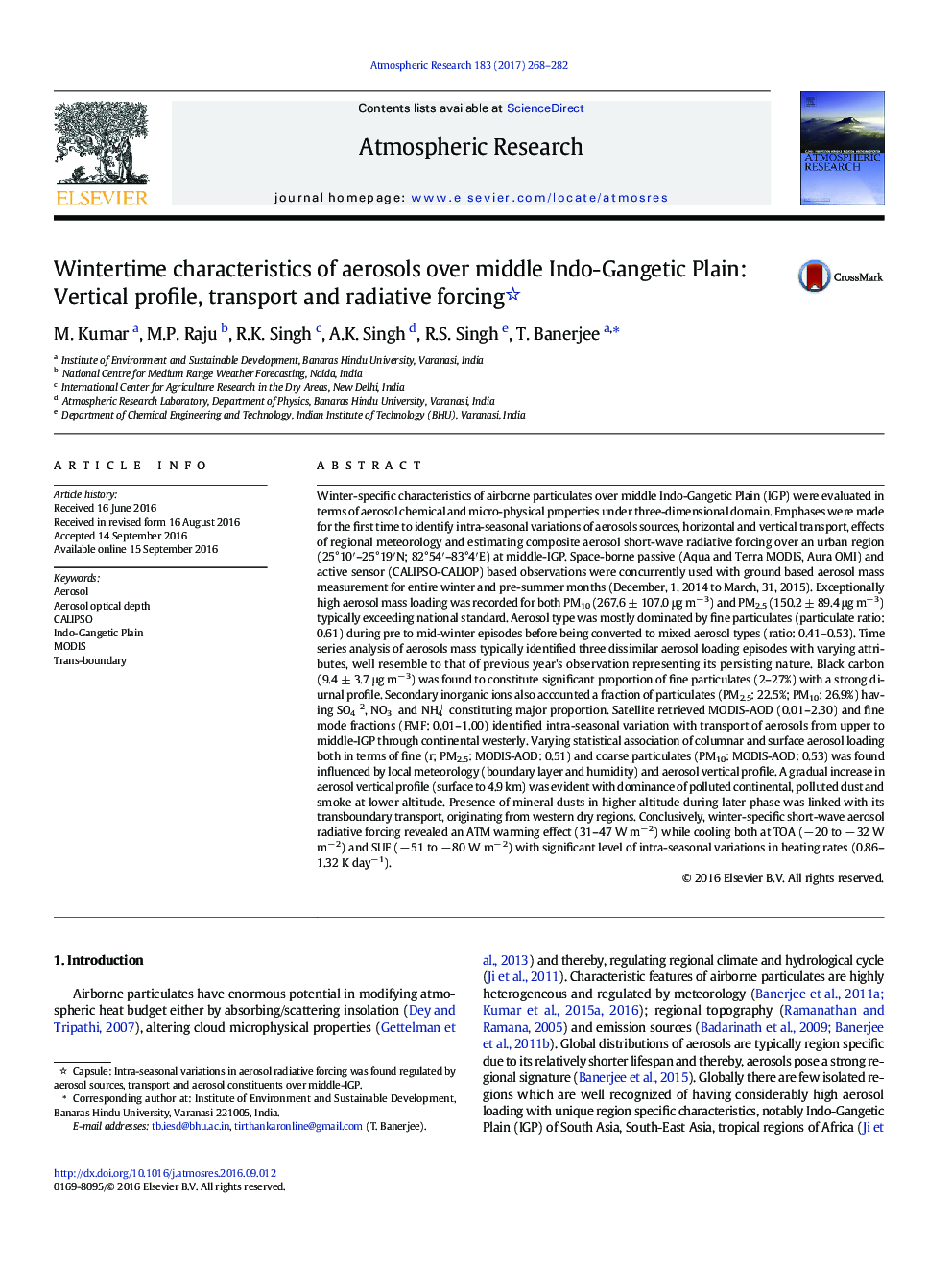| کد مقاله | کد نشریه | سال انتشار | مقاله انگلیسی | نسخه تمام متن |
|---|---|---|---|---|
| 4449565 | 1620498 | 2017 | 15 صفحه PDF | دانلود رایگان |
• Typical pattern in winter-specific aerosol loading over middle-IGP was recognized.
• Intra-seasonal variation in MODIS-AOD and FMF was consistent with source strengths.
• At higher altitude accumulation of dusts were linked to trans-boundary origin.
• At lower altitude continental westerly accumulates smoke from upper to middle-IGP.
• Cooling at SUF & TOA and warming at ATM leading to high heating rates.
Winter-specific characteristics of airborne particulates over middle Indo-Gangetic Plain (IGP) were evaluated in terms of aerosol chemical and micro-physical properties under three-dimensional domain. Emphases were made for the first time to identify intra-seasonal variations of aerosols sources, horizontal and vertical transport, effects of regional meteorology and estimating composite aerosol short-wave radiative forcing over an urban region (25°10′–25°19′N; 82°54′–83°4′E) at middle-IGP. Space-borne passive (Aqua and Terra MODIS, Aura OMI) and active sensor (CALIPSO-CALIOP) based observations were concurrently used with ground based aerosol mass measurement for entire winter and pre-summer months (December, 1, 2014 to March, 31, 2015). Exceptionally high aerosol mass loading was recorded for both PM10 (267.6 ± 107.0 μg m− 3) and PM2.5 (150.2 ± 89.4 μg m− 3) typically exceeding national standard. Aerosol type was mostly dominated by fine particulates (particulate ratio: 0.61) during pre to mid-winter episodes before being converted to mixed aerosol types (ratio: 0.41–0.53). Time series analysis of aerosols mass typically identified three dissimilar aerosol loading episodes with varying attributes, well resemble to that of previous year's observation representing its persisting nature. Black carbon (9.4 ± 3.7 μg m− 3) was found to constitute significant proportion of fine particulates (2–27%) with a strong diurnal profile. Secondary inorganic ions also accounted a fraction of particulates (PM2.5: 22.5%; PM10: 26.9%) having SO4− 2, NO3− and NH4+ constituting major proportion. Satellite retrieved MODIS-AOD (0.01–2.30) and fine mode fractions (FMF: 0.01–1.00) identified intra-seasonal variation with transport of aerosols from upper to middle-IGP through continental westerly. Varying statistical association of columnar and surface aerosol loading both in terms of fine (r; PM2.5: MODIS-AOD: 0.51) and coarse particulates (PM10: MODIS-AOD: 0.53) was found influenced by local meteorology (boundary layer and humidity) and aerosol vertical profile. A gradual increase in aerosol vertical profile (surface to 4.9 km) was evident with dominance of polluted continental, polluted dust and smoke at lower altitude. Presence of mineral dusts in higher altitude during later phase was linked with its transboundary transport, originating from western dry regions. Conclusively, winter-specific short-wave aerosol radiative forcing revealed an ATM warming effect (31–47 W m− 2) while cooling both at TOA (− 20 to − 32 W m− 2) and SUF (− 51 to − 80 W m− 2) with significant level of intra-seasonal variations in heating rates (0.86–1.32 K day− 1).
Figure optionsDownload as PowerPoint slide
Journal: Atmospheric Research - Volume 183, 1 January 2017, Pages 268–282
